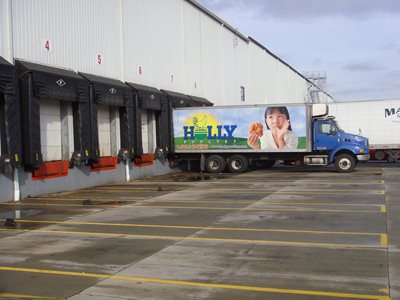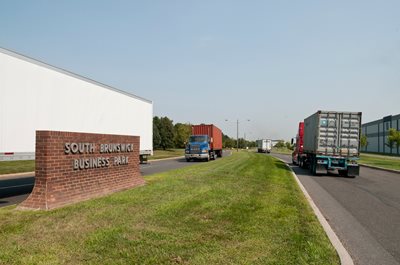There are many good jobs in the freight sector but attracting workers to them can be difficult as freight facilities often are not easily accessible via public transportation.
The Metropolitan Area Planning (MAP) Forum's Multi-State Freight Working Group hosted a virtual peer exchange workshop on Nov. 15 titled, “Effective Practices for Enhancing Last Mile Workforce Accessibility Options to Freight Facilities.” The panel included a representative from the private sector, a Transportation Management Association (TMA), and a community non-profit that provides a fee-for-service program.
 It's not just a freight and transportation issue, David Behrend, Executive Director of the North Jersey Transportation Planning Authority (NJTPA), said. “It’s really an equity issue because a lot of these facilities may be located in traditionally underserved communities …and have the potential to really economically benefit those communities,” he said.
It's not just a freight and transportation issue, David Behrend, Executive Director of the North Jersey Transportation Planning Authority (NJTPA), said. “It’s really an equity issue because a lot of these facilities may be located in traditionally underserved communities …and have the potential to really economically benefit those communities,” he said.
A lack of access to transit can potentially shut the door on a six-figure salary for people with a high school diploma, according to Axel Carrion, Vice President, State Government & Public Affairs, at UPS. He said he would not be a vice president today if almost 30 years ago he did not have access to transit in New York City to get his foot in the door at the company.
UPS is the fourth-largest largest private employer in New Jersey. The challenges with worker access, including access during overnight hours, Carrion said is “not a UPS issue by any means, it’s an industry issue.”
Della Walker, Jr., chief operating officer and executive vice president of programs at the non-profit Newark Alliance, explained how creating equitable transportation solutions can eliminate barriers to work. Transportation systems should be flexible and responsive to the needs of employers and workers, Walker said. “There’s not one solution that will fit everyone’s needs.”
The alliance has helped reduce commutes by assessing where people work, making sure schedules address their needs and encouraging companies to hire locally.
Serving warehouse districts with transit can be particularly difficult, according to Peter Bilton, Manager, Sustainable Transportation Planning, at the NJTPA. because they tend to be single-use districts with no residents, making transit “less cost efficient” than in more populous areas.
Common solutions include:
- Vanpooling, in which a group of employees lease from a vendor and commute together, often with subsidies available to support it;
- Van shuttles, provided by an employer or employment agency for home-to-work transport, which works best at workplaces with a large workforce and consistent shifts;
- Carpooling, promoted by employers and supported by TMAs; and,
- Shuttlebuses, specifically tailored to freight workplace needs, with a fixed or flexible route and schedule, funded by public-private partnerships.
 The area around Allentown, Pennsylvania, is also facing difficult worker access issues. Owen O’Neil, executive director of Lehigh and Northampton Transportation Authority (LANTA) said that since 2016 the region has seen some 30 million square feet of logistics and warehouse space approved or constructed – with another 26 million in the approval process.
The area around Allentown, Pennsylvania, is also facing difficult worker access issues. Owen O’Neil, executive director of Lehigh and Northampton Transportation Authority (LANTA) said that since 2016 the region has seen some 30 million square feet of logistics and warehouse space approved or constructed – with another 26 million in the approval process.
LANTA has 85 buses covering 324 square miles of service area but faces the demand for more service as development grows and spreads “We don’t have a whole lot of resources to cover all the things we have to do,” O’Neil said.
He noted that the newest employees at warehouses tend to be the most reliant on transit and get the worst shifts until they work their way up. It’s only after a year or two, when they are in steady situations, that they might buy a car or start carpooling, he added.
In the New Jersey Meadowlands area, the non-profit Meadowlands Transportation Brokerage Campaign, more commonly known as EZ Ride, helps businesses get their employees to work.
“Transportation can be a challenge, for people who cannot afford to drive to work, for older adults who don’t drive [and for] those with disabilities,” Krishna Murthy, president and CEO of EZ Ride, said. To provide affordable services, EZ Ride often develops public-private partnerships to fund operations.
Among the organization’s most vital programs is EZ Ride Shuttles. On a typical day pre-COVID, EZ Ride would transport about 2,000 people a day via 30 vehicles by 100 drivers. About one-third of shuttles operate at night, between 1 a.m. and 5 a.m., getting people to Newark Penn Station. Ridership is down about 20 percent since COVID began, with EZ Ride transporting about 400 people a day on average.
A complete recording of the meeting and presentations can be accessed here.